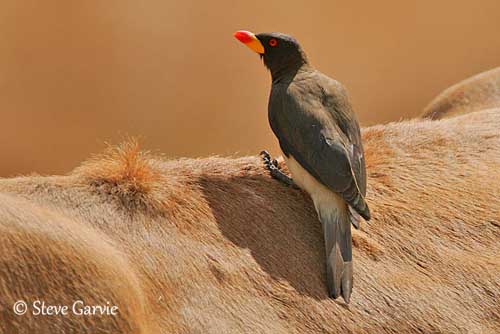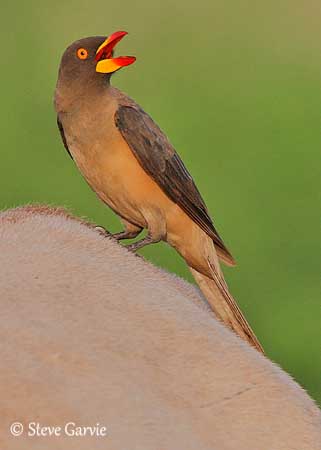
Fr: Piquebœuf à bec jaune
All : Gelbschnabel-Madenhacker
Esp : Picabueyes Piquigualdo
Ital : Bufaga beccogiallo
Nd : Geelsnavelossenpikker
Sd : Gulnäbbad oxhackare
Photographers:
Steve Garvie
RAINBIRDER Photo galleries
Ingo Waschkies
Bird Photography
Text by Nicole Bouglouan
Sources:
HANDBOOK OF THE BIRDS OF THE WORLD Vol 14 by Josep del Hoyo-Andrew Elliot-David Christie - Lynx Edicions – ISBN: 9788496553507
BIRDS OF AFRICA SOUTH OF THE SAHARA by Ian Sinclair and Peter Ryan - Princeton University Press Princeton and Oxford - ISBN: 0691118159
ROBERTS BIRDS OF SOUTH AFRICA by G. R. Mc Lachlan and R. Liversidge – The Trustees of the John Voelcker Bird Book Fund – ISBN: 0620031182
L’ENCYCLOPEDIE MONDIALE DES OISEAUX - Dr Christopher M. Perrins - BORDAS - ISBN: 2040185607
BirdLife International (BirdLife International)
CREAGUS@Monterey Bay (Don Roberson)
Wikipedia, the free encyclopaedia
Yellow-billed Oxpecker
Buphagus africanus
Passeriforme Order – Buphagidae Family
INTRODUCTION:
The family Buphagidae includes only two species, the Yellow-billed Oxpecker and the Red-billed Oxpecker. The name “oxpecker” is related to their habit of perching on large wild and domestic mammals. They remove the ticks from these animals, but in spite of destroying parasites, the farmers often dislike them.
Sometimes placed in the Sturnidae family, they differ from starlings by the bill shape and the short, sharply curved claws.
DESCRIPTION OF THIS BIRD:
Biometrics:
Length: 20 cm
Weight: 57-70 g
The adult of nominate race has dark brown to olive-grey upperparts, including upperwing and tail. However, there is a contrast with the light buffy rump and uppertail-coverts which show sometimes a greyish wash.
The underparts are pale brown from breast to undertail-coverts.
Head and throat are similar to upperparts.
The laterally flattened bill has broad lower base and bulbous culmen near the tip. The bill is yellow with red distal portion. The eyes are red or orange, with narrow eyering. Legs and feet are dark brown to blackish.

Both sexes are similar.
The juvenile resembles adult in plumage, but it has yellow bill first, and narrow yellow eyering around its brown eye. It obtains the adult plumage within the first year.
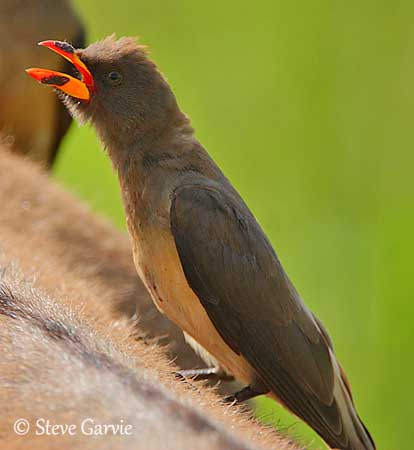
SUBSPECIES AND RANGE:
There are two subspecies. Information is required about their movements, but regular dispersal may occur.
B.a. langi occurs in Congo Basin in Gabon, W Congo and W Angola. This race is smaller than nominate and has darker plumage with greyish rump.
B.a. africanus (here described and displayed) occurs in SW Mauritania and Senegal, E to W, S and E Sudan, NW Ethiopia and W Eritrea. It is locally present in SW Angola and N and NE Namibia, and very locally from Uganda and Kenya, S to Zambia, Malawi, N Botswana, Zimbabwe, C Mozambique and NE South Africa.
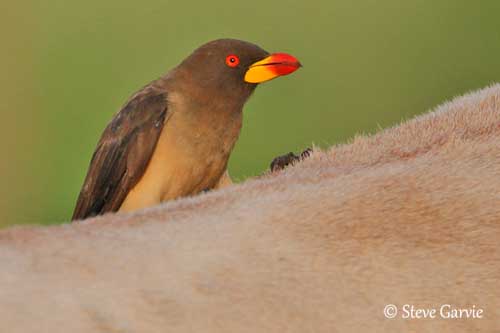
CALLS AND SONGS: SOUNDS BY XENO-CANTO
The Yellow-billed Oxpecker gives short, hissing “kriss, kriss” in alarm. The flight call is a high-pitched buzzing “peep peep” uttered while circling during the flight displays.
The young birds give hollow “chok” notes and snake-like “tchisss” when threatened.
No song described.
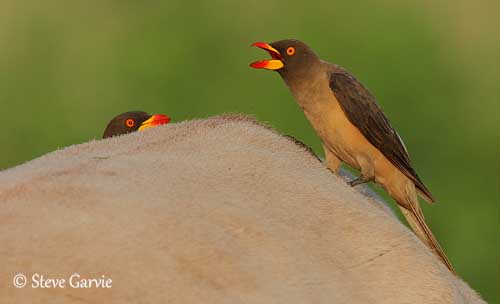
HABITAT:
The Yellow-billed Oxpecker frequents open savannas and broad-leafed woodlands, often near water. It usually occurs in association with wild and domestic large mammals. It often roosts in trees close to these animals, or even on buffaloes’ back at night.
BEHAVIOUR IN THE WILD:
The Yellow-billed Oxpecker feeds primarily on ticks, but with preference for particular species and for stages in the ticks’ life-cycle.
It also catches biting insects and large ticks such as engorged females of Amblyomma hebraeum.
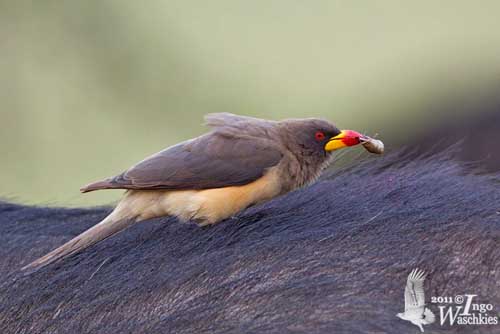
Parasites are removed from hosts as well by pecking and plucking with the bill tip, as by “scissoring”, moving it sideways against the skin, alternately opened and closed. The prey is detected by touch in the latter technique.
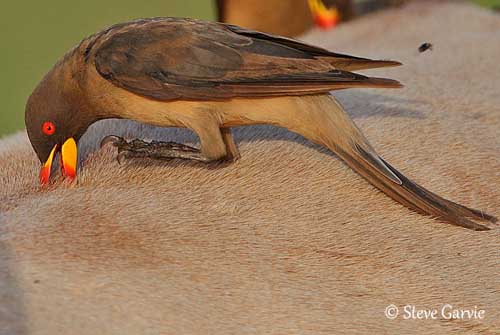
The feeding behaviour depends on the hair structure of each animal host, and scissoring is mainly used on long-haired mammals.
The Yellow-billed Oxpecker also feeds at wounds and skin lesions infected with parasites. It is reported that the bird also takes blood and fragments of tissue from these wounds. They may feed on carrion at animal carcasses too.
It feeds by hanging on the side of the mammal and usually out of sight. It clambers about while searching for ticks, and peers over the host’s back. It leaves the host and comes down to the ground for dust-bathing or for bathing in water, and for drinking.
During the breeding season, courtship and copulation often occur on the host animal. However, aerial courtship displays are reported, during which the bird circles in the air while calling. They are monogamous and co-operative breeders with helpers. The breeding pair is usually assisted by one to six helpers which take part in most of nesting duties except the incubation.
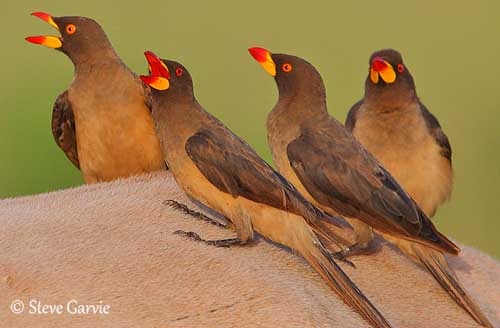
The Yellow-billed Oxpecker does not need to fly long-distances, and is often passively carried by buffaloes which usually travel up to 8 kilometres a day. Some dispersal, mainly by females, is reported.
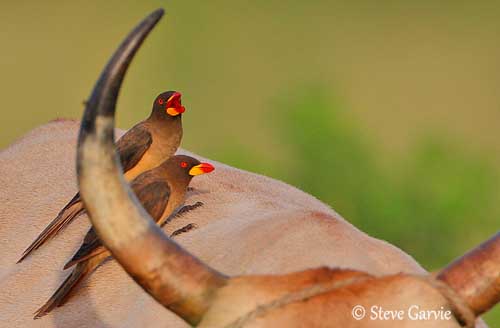
REPRODUCTION OF THIS SPECIES:
The breeding season varies according to the range, but it is closely linked to the rainfall.
The Yellow-billed Oxpecker nests in tree hole, a natural cavity or an abandoned woodpecker’s hole. The nest-site is defended against other oxpeckers, but also starlings and parrots.
The cavity is placed between 2 and 15 metres above the ground. It is lined with hair from host mammals, dry grass, twigs and occasionally some feathers.
The female lays 2-3 white to creamy eggs with variable markings. The incubation lasts 13 days or more and is usually shared by both adults. The chicks are fed both by parents and helpers. They fledge about 25 days after hatching.
PROTECTION / THREATS / STATUS:
The Yellow-billed Oxpecker is locally common due to its wide, but fragmented range. It is present in many protected areas, and the species is not currently threatened, in spite of reduction of parasites due to pesticides and livestock control.
